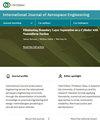A Multiple Object Tracker with Spatiotemporal Memory Network
IF 1.2
4区 工程技术
Q3 ENGINEERING, AEROSPACE
引用次数: 0
Abstract
Target tracking is an important application of unmanned aerial vehicles (UAVs). The template is the identity of the target and has a great impact on the performance of target tracking. Most methods only keep the latest template of the target, which is intuitive and convenient but has poor ability to resist the change of target appearance, especially to reidentify a target that has disappeared for a long time. In this paper, we propose a practical multiobject tracking (MOT) method, which uses historical information of targets for better adapting to appearance variations during tracking. To preserve the spatial-temporal information of the target, we introduce a memory pool to store masked feature maps at different moments, and precise masks are generated by a segmentation network. Meanwhile, we fuse the feature maps at different moments by calculating the pixel-level similarity between the current feature map and the masked historical feature maps. Benefiting from the powerful segmentation features and the utilization of historical information, our method can generate more accurate bounding boxes of the targets. Extensive experiments and comparisons with many trackers on MOTS, MOT17, and MOT20 demonstrate that our method is competitive. The ablation study showed that the introduction of memory improves the multiobject tracking accuracy (MOTA) by 2.1.基于时空记忆网络的多目标跟踪器
目标跟踪是无人机的一项重要应用。模板是目标的身份,对目标跟踪的性能有很大的影响。大多数方法只保留目标的最新模板,直观方便,但抵抗目标外观变化的能力较差,特别是对消失已久的目标的重新识别能力较差。本文提出了一种实用的多目标跟踪方法,该方法利用目标的历史信息来更好地适应跟踪过程中的外观变化。为了保留目标的时空信息,我们引入内存池存储不同时刻的掩码特征映射,并通过分割网络生成精确的掩码。同时,通过计算当前特征图与被屏蔽的历史特征图的像素级相似度,融合不同时刻的特征图。该方法利用了强大的分割特性和对历史信息的利用,可以生成更精确的目标边界框。大量的实验和与许多MOTS, mo17和mo20跟踪器的比较表明,我们的方法是有竞争力的。烧蚀研究表明,记忆的引入使多目标跟踪精度(MOTA)提高2.1。
本文章由计算机程序翻译,如有差异,请以英文原文为准。
求助全文
约1分钟内获得全文
求助全文
来源期刊

International Journal of Aerospace Engineering
ENGINEERING, AEROSPACE-
CiteScore
2.70
自引率
7.10%
发文量
195
审稿时长
22 weeks
期刊介绍:
International Journal of Aerospace Engineering aims to serve the international aerospace engineering community through dissemination of scientific knowledge on practical engineering and design methodologies pertaining to aircraft and space vehicles.
Original unpublished manuscripts are solicited on all areas of aerospace engineering including but not limited to:
-Mechanics of materials and structures-
Aerodynamics and fluid mechanics-
Dynamics and control-
Aeroacoustics-
Aeroelasticity-
Propulsion and combustion-
Avionics and systems-
Flight simulation and mechanics-
Unmanned air vehicles (UAVs).
Review articles on any of the above topics are also welcome.
 求助内容:
求助内容: 应助结果提醒方式:
应助结果提醒方式:


